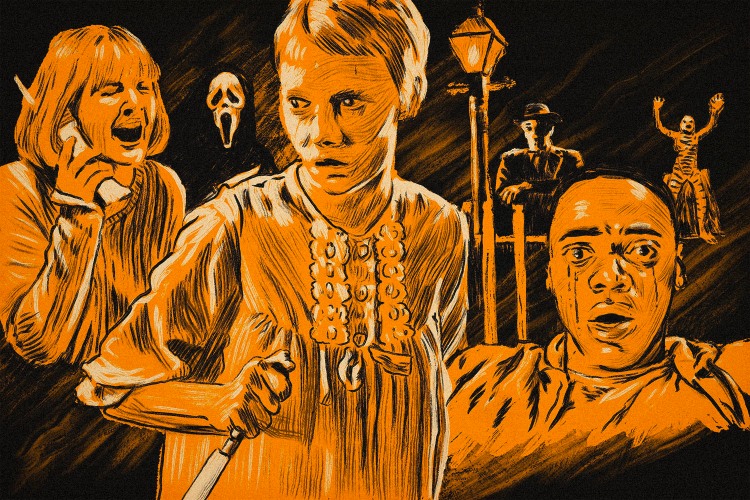Why Did Pennywise Eat Children?
Curiosity may have led you down a dark and twisted path, wondering, “Why did Pennywise eat children?” Well, my friend, prepare to delve into the chilling depths of this horrifying tale. Pennywise, the shape-shifting entity known as “It,” has haunted the nightmares of many for years. But what drives this malevolent creature to prey upon innocent children? Let’s uncover the sinister motivations behind Pennywise’s insatiable hunger.
To comprehend why Pennywise feasts upon children, we must first understand the essence of its existence. This maleficent being originated from the works of the master of horror himself, Stephen King. In his novel, “It,” Pennywise embodies the embodiment of fear, a force that thrives on the terror of its victims. It manifests as a clown to exploit the fears of children, drawing them in with its whimsical facade before unleashing its true monstrous form.
But why children? Well, my dear reader, children possess an untainted and potent fear, untouched by the rationality and skepticism that often accompanies adulthood. Their vivid imaginations and vulnerability make them perfect prey for Pennywise’s insidious intentions. By devouring their fears, Pennywise not only sustains its own existence but also gains power from the terror it instills. It thrives on the innocence it extinguishes, reveling in the darkness that engulfs its victims. So, the next time you encounter a clown with a red balloon, beware, for Pennywise lurks, hungry for the fears of children.

Why Did Pennywise Eat Children?
Pennywise the Dancing Clown, the terrifying antagonist from Stephen King’s novel “It,” has haunted the nightmares of readers and moviegoers alike. One of the most chilling aspects of Pennywise’s character is his insatiable hunger for children. But why did Pennywise specifically target and consume innocent young lives? In this article, we will delve into the dark origins of Pennywise’s appetite for children and explore the psychological and supernatural factors that drive his horrifying actions.
The Origin of Pennywise
Pennywise, also known as It, is an ancient cosmic entity that awakens every 27 years to feed on fear and flesh. It takes the form of a clown to prey upon the fears of children, as their fears are easier to manipulate and exploit. Pennywise’s origins can be traced back to the Macroverse, a dimension beyond our own, where It thrives on chaos and fear.
According to the novel, Pennywise arrived on Earth millions of years ago, crashing into the planet in the form of a massive asteroid. It settled in the area that would later become Derry, a small town in Maine, and began its reign of terror. By consuming the fear and flesh of children, Pennywise sustains its existence and perpetuates the cycle of fear that keeps it alive.
The Hunger for Fear
Pennywise feeds on fear, and children offer a particularly potent source of this primal emotion. The fears of children are often more intense and irrational, making them easier for Pennywise to exploit. By preying on their deepest fears and anxieties, Pennywise gains power and sustenance.
Children are also more vulnerable and susceptible to Pennywise’s manipulation. Their imaginations are vivid, and they possess an innocence that can be easily corrupted. Pennywise uses its shape-shifting abilities and deceptive charm to lure children into its clutches, promising them a world of wonders and excitement before revealing its true monstrous form.
The Role of the Ritual of Chüd
In the novel, a group of children known as the Losers Club discovers a ritual called the Ritual of Chüd, which allows them to battle Pennywise and weaken its hold on Derry. The Ritual of Chüd involves engaging in a psychic battle with Pennywise, using their own willpower and belief to overcome the fear that sustains the creature.
The ritual symbolizes the power of unity and the strength that can be found in facing one’s fears together. By banding together, the Losers Club is able to resist Pennywise’s manipulation and ultimately defeat the creature. However, the cycle of fear and Pennywise’s hunger for children is never truly broken, as It continues to return every 27 years to terrorize Derry once again.
The Psychological Motivations of Pennywise
While Pennywise is a supernatural entity, its actions can also be interpreted through a psychological lens. The character represents the embodiment of fear and the ways in which it can consume and control individuals. Pennywise preys upon the vulnerabilities and insecurities of its victims, exploiting their deepest fears to gain power and control over them.
Pennywise’s hunger for children can be seen as a reflection of the vulnerability and innocence of childhood. Children are often more susceptible to fear and manipulation, making them ideal targets for Pennywise’s malevolent intentions. By feeding on children, Pennywise symbolizes the loss of innocence and the corruption of purity.
The Effects of Fear
Fear has a profound impact on the human psyche, often leading to irrational thoughts and behaviors. Pennywise exploits this vulnerability, using fear as a means of control. Its ability to transform into various forms, each tailored to the specific fears of its victims, amplifies the terror and ensures its hold over them.
Furthermore, the fear that Pennywise instills in its victims creates a sense of isolation and powerlessness. Victims are often too afraid to seek help or confide in others, allowing Pennywise to maintain its grip on their minds and souls. This psychological manipulation adds an additional layer of horror to Pennywise’s actions.
In conclusion, Pennywise’s insatiable hunger for children can be attributed to its need for fear and sustenance. By targeting children, Pennywise exploits their vulnerability, amplifies their fears, and gains power and control over them. Through understanding the origins and psychological motivations of Pennywise, we can gain a deeper insight into the chilling nature of this iconic horror character.
Key Takeaways: Why did Pennywise eat children?
- Pennywise, the terrifying clown from Stephen King’s novel “It,” feeds on fear.
- Children’s fear is particularly potent for Pennywise, making them his preferred victims.
- Pennywise’s true form is unknown, but he takes the shape of a clown to lure children.
- By feeding on children’s fear, Pennywise prolongs his own existence.
- Pennywise’s hunger for children is driven by his insatiable appetite and need to survive.
Frequently Asked Questions
Pennywise, the terrifying clown from Stephen King’s “It,” is known for his insatiable appetite for children. Here are some frequently asked questions about why Pennywise eats children and the motivations behind this disturbing behavior.
Q: What is the reason behind Pennywise eating children?
Pennywise, also known as It, feeds on the fear and flesh of children. The entity awakens every 27 years to terrorize the town of Derry, Maine, and preys on the vulnerable and innocent. It targets children because they are easier to manipulate and their fears are more potent.
By consuming their fear, Pennywise gains strength and sustenance. It’s believed that the fear and negative emotions emitted by children are like a delicacy to It, providing it with a powerful energy source to survive and continue haunting Derry.
Q: Does Pennywise have a specific reason for choosing children as its victims?
Pennywise selectively targets children for several reasons. Firstly, children are more susceptible to fear and are easier to manipulate. Their imaginations are vivid, and their fears are often more intense and irrational, making them ideal prey for Pennywise.
Additionally, the loss of a child has a greater impact on a community, creating a deep sense of fear and despair. This amplifies the negative emotions that Pennywise feeds on, making its presence more potent and terrifying.
Q: Is there a psychological explanation for Pennywise’s preference for children?
Psychologically, the choice to target children aligns with the concept of pedophilic disorder. However, it’s important to note that Pennywise is a supernatural entity and not a human being. Its motivations and actions are rooted in the realm of horror fiction, where the lines between reality and fantasy blur.
Pennywise’s preference for children can also be seen as a symbol of innocence corrupted. By preying on the most vulnerable members of society, Pennywise represents the darkness that exists in the world and the loss of childhood innocence.
Q: Does Pennywise have any specific criteria for choosing its victims?
Pennywise doesn’t have rigid criteria for selecting its victims. It thrives on fear and will target anyone, regardless of age or background, as long as they provide a sufficient source of terror. However, children are often more susceptible to its manipulation and more easily frightened, making them prime targets.
Pennywise’s ability to shape-shift and take on various forms allows it to exploit the specific fears of its victims, making the experience even more terrifying. It adapts to each individual’s fears, ensuring a personalized nightmare for every child it encounters.
Q: Can Pennywise be stopped from eating children?
Pennywise’s existence is deeply rooted in the supernatural, making it challenging to defeat or eradicate completely. However, in the world of “It,” a group of brave individuals called the Losers’ Club stands up against Pennywise, using their resilience and friendship to confront and ultimately defeat the malevolent entity.
While Pennywise may never be permanently stopped, the power of unity, love, and facing one’s fears can weaken its grip on a community. The strength of human connection and the refusal to succumb to fear are powerful weapons against the terror Pennywise instills.
Why Does Pennywise Kill Children? | IT
Final Thoughts on Why Pennywise Eats Children
After delving into the world of Pennywise the Dancing Clown, it becomes clear that there are several reasons why he preys on innocent children. It goes beyond a mere hunger for sustenance or a desire for power. Pennywise feeds on the fear and vulnerability of children, using their deepest fears as a source of nourishment.
One possible explanation is that Pennywise targets children because they are more susceptible to fear. Their imaginations are wild and untamed, making them easy targets for his manipulations. By feeding on their fears, Pennywise gains strength and sustenance. This cruel cycle perpetuates as he continues to haunt and devour the children of Derry.
Another reason why Pennywise chooses to feast on children is the lasting impact it has on the town. The disappearance and deaths of children create a sense of terror and helplessness within the community. This fear allows Pennywise to thrive and maintain his power. By targeting the most vulnerable members of society, he ensures that his reign of terror remains unchallenged.
In conclusion, Pennywise’s insatiable appetite for children stems from his need to feed on their fear and vulnerability. This choice not only perpetuates his own existence but also instills a deep sense of terror in the community. The haunting presence of Pennywise serves as a reminder of the darkness that lurks beneath the surface, and the importance of facing our fears head-on.






